| |
1.
|
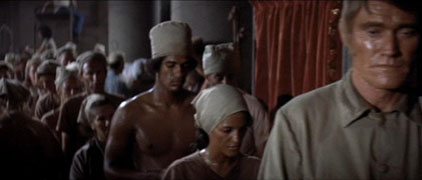 |
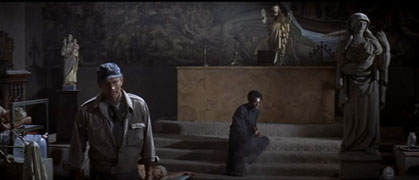 |
 |
|
| |
Matthew
Tsui M
The role of the church has reverted to times of old. Comment.
|
|
| |
2.
|
 |
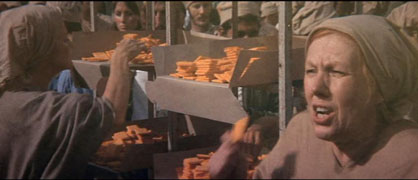 |
 |
x |
| |
Duncan
Bates 3B
Global warming has resulted in constant temperatures in excess of 95F. Farmland
is almost non-existent and food has been reduced to a product comprised
of soya, lentils and plankton. How has this altered life in general?
The presentation of food as a ‘coupon-like’
token of life in Soylent Green reduces the character and social stature
of food to that of just another mass-produced material. The representation
of food in this movie embellishes the concept of mass-production, uniformity
and equality. Furthermore, this notion of mass-production, and the elimination
of any qualities familiar to the viewer identify and relate further to the
concept of the dwindling food supply caused by global warming. This epidemic
is accentuated in the 70’s with the cold war and American oil crisis
during which time fuel supplies were rationed. The representation and handling
of food in a manner similar to that of the oil crisis allows the viewer
to identify with the hardships and difficulties facing the citizens of New
York. Additionally, by representing the food in this manner, an immediate
removal of the soul of the citizens occurs in that food and the process
of producing a meal is perhaps one of the most fundamental identifiers of
a culture, nationality, individuality and pride. By eliminating this identifier
from the equation, the citizens of New York become a faceless entity whose
sole purpose is to conform to the rules and regulations of an authority
trying to surge forward towards a future of prosperity. Finally, in the
context of this movie, the citizens of New York are forced, through unemployment,
to spend their days lining up to get whatever they can of these morsels
of food only to
discover at a later date that they are consuming themselves. |
|
| |
3. |
 |
 |
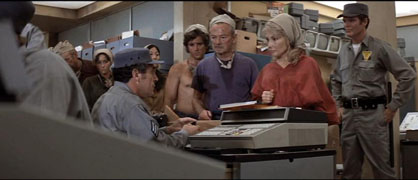 |
|
| |
Eric
Boyko 3B
Rationing has become a way of life for the more than 50% of the population
that is unemployed. Bare survival is difficult. Comment.
“Soylent Green” depicts an extremely bleak
vision of the future where the modern world has collapsed in on itself.
Humanity has wiped out the natural world and collaged the entire globe,
it seems, with city grids. It is a wonder that the air is fresh enough to
maintain any form of life in the city whatsoever. Farm land is a far off
fantasy realm that must be insufficient in area to sustain, or even give
a taste of natural foods to anyone but the super wealthy.
Instead, a large corporation manufactures
dry ‘supplementary-like’ foods to feed the masses. They line
up to receive their rations of these crackers and water weekly. Bare survival
is difficult due to the schism of man and his means to live naturally.
He has become a mere extension of the machine that has overrun the world,
incapable of operating separate from, or against it.
Today, within the modern city we pass through our daily lives without
giving a thought to our individual survival needs; we purchase our food
at the grocery store, take transit to work, and then back home to a dwelling
already planned and built for us. We have no understanding of the systems
that provide for us. “Soylent Green” projects this condition
beyond moral boundaries. The city is a labyrinth. Everything is enshrouded
in secrecy to the point that cannibalism can be unleashed unknowingly
on the public. There is no freedom; the survival needs for which people
fight are produced only by other humans, none by nature.
|
|
| |
4. |
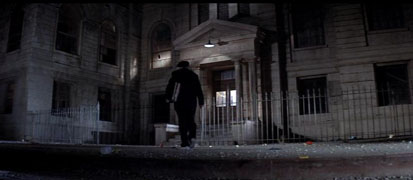 |
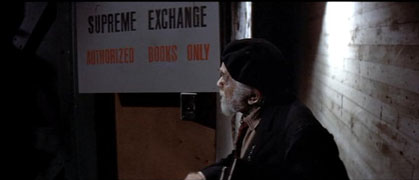 |
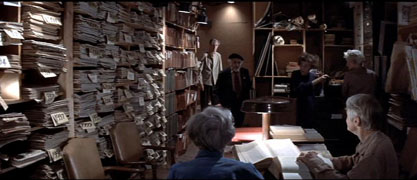 |
|
| |
Bryan
Jin M
Books, and paper products in general, have become near to extinct. Not everyone
can read. The library houses the judges who must be seen on the sly. Comment. |
|
| |
5. |
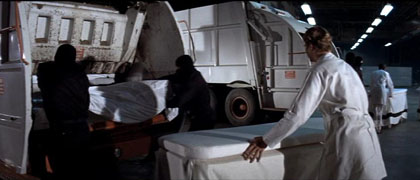 |
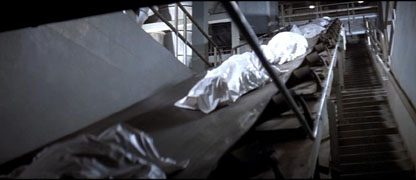 |
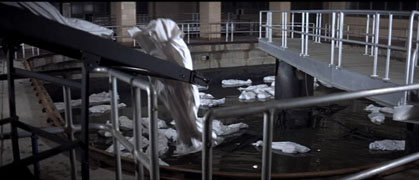 |
|
| |
Neil
Brun 3B
Regard for human life has ceased. Human beings have
become a "commodity". Comment.
Human species, regardless of culture, treat death
as something deserving of ceremony. We still see something of the person
we knew and loved in the body that remains, so we make every effort to preserve
the body until a proper ceremony can be arranged through burial, cremation
or another custom.
While is clear in the world of Soylent Green that people still attach value
to the bodies of the deceased, the film explores a world in which overpopulation
makes humans obstacles in life but resources in death and centres around
the methods that have been conceived for accessing and exploiting this resource.
Infrastructure has been put in place to encourage and process depopulation
on an effective scale, however the plot line centres around the most shocking
aspect of this system which is the recycling of corpses into food.
After witnessing Sol’s mercy killing, we see the euthanasia clinic
for what it really is – a front for producing raw materials for export.
The angelic men and women dressed in white that so tenderly attended to
their patients indoors are now helping a group of sinister looking men dressed
in black compact the bodies into a garbage truck. Here the analogy is quite
opaque: the bodies are waste and thus are being treated in this fashion.
The next couple images show the corpses being processed through a complex
system of conveyors, tanks and ramps that seem eerily reminiscent of food
processing and packaging plants. This analogy grows creepily more established
in the audiences mind until their suspicions are confirmed. It is important
to note that while the balance of the film takes place essentially in the
dark ages, (where food, water, bathing, power, literature and culture are
considered luxuries), this scene is conducted in a large, clean, well-lit
space. The setting, set against the noisy backdrop of powerful machines
and tidy, efficient workers in white coats provides a strong image of the
industrial age, while the subject matter, (a kind of corporately sponsored
cannibalism) provides a strong commentary on what the industrial age represents.
The evil and lack of morality commonly associated with capitalism is expounded
as we realize just how the rich have been getting rich.
This way this film portrays the pitiful and demoralized lives of the future
is disturbing, with the subjugation of women and the notion of treating
humans as resources. But what really disturbs us is the way death is shown
to have no meaning, as it naturally implies that life can have no meaning.
|
|
| |
6. |
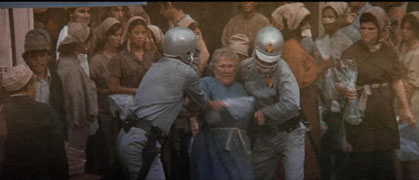 |
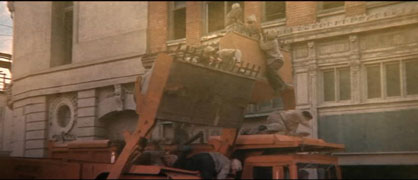 |
 |
|
| |
Johnathan
Wong 4A
Crowd control at its best. How is this purposeful??
The slightly absurd nature of this scene raises the
question of the value of human dignity and the abstraction of the individual
into a dispensible byproduct of a civilization in decline. The methods used
by the riot police to suppress a woman’s dismay at not getting enough
food rations illustrates how easily the will to maintain order can infringe
upon a person’s right to free speech in a supposed democratic society.
As word is announced that there is a shortage of food we witness tempers
flare with the subsequent upturning of kiosks and general chaos—that
is, the individual voice trying to assert itself. The camera angle then
shifts to above head level, revealing the mass of ragged-looking people
struggling against each other, not unlike a herd of cattle, wherein the
football helmeted officers begin herding them into the ‘scoops’
that arrive soon after the riot breaks out. The reference to cattle is probably
not a coincidence. The sequence in which people are being hoisted (harvested?)
into the backs of trucks with steel-toothed scoops is eerily reminiscent
of images of dead cows being shovelled into pits as a consequnce of the
mad cow crisis in europe or, closer to home, the recent Aylmer Meats investigation.
It depicts graphically how difficult conditions—in the case of the
film, overpopulation, lack of resources, and inequal powers of governance—allows
such injustices to happen almost as a matter of course. It paints a bleak
picture of the future indeed. |
|
| |
7. |
 |
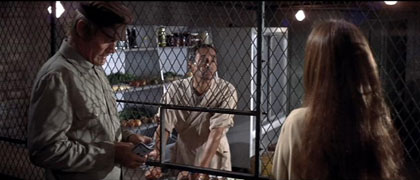 |
 |
|
| |
Anna
Jarvis 3B
Real food is reserved for black market purchases by the very wealthy. How
does this change the entire perspective on living and life? Expand.Because
real food in the Soylent world can only be purchased illegally for exorbitant
prices, the current relationship between upper and lower classes has been
seemingly reversed. For all of the modern age, the vast majority of people
in the “developed” world have been able to buy a variety of
foods at reasonable prices. The relative wealth of the modern age, with
regards to past ages, has meant that in addition to meeting basic needs,
the average person has been able to indulge in vice, and vice has become
commonly associated with poorer, lower-class people.
In
the movie, however, it seems that society is regressing; it has reverted
to a medieval situation where the vast majority of people eat just to
survive, as in the dark ages. In both the past and the movie’s vision
of the future, the food of the poor was, and is, very bland; medieval
peasants got thin, watery gruel, and the common people of the future in
Soylent Green get bright-coloured plasticky chunks of soy, human, and
plankton-based products.
It
is interesting that what is considered an extravagant, sinful, illegal
way of life in Soylent is so similar to that of the ordinary person in
the 70’s. It raises the question of whether the way most people
were living in the 70’s was sinfully extravagant as well. In the
Soylent world, which has very limited natural resources, it can be assumed
that growing vegetables, not to mention raising cattle, uses up resources
which are not available for everyone. During the 70’s, people in
“developed” countries started considering the implications
of their exploitive resource use, so it is not surprising that a movie
like Soylent chooses to take contemporary environmental fears and extrapolate
them into the future to create its dystopic vision of the future, in which
the senses of most people have been dulled, and there seems to be no reason
for many people to live; the majority of people have no pleasant visual,
aural, olefactory, alimentary or mental stimuli.
|
|
| |
8. |
 |
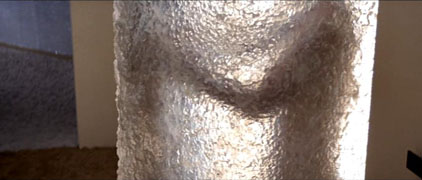 |
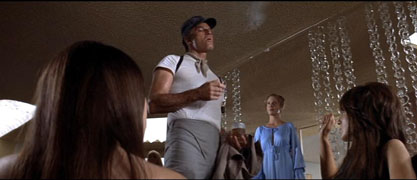 |
|
| |
Ava
Franzolini M
Vice still exists, but seems reserved for the extremely
wealthy. Women have become "furniture". Comment on the role of
vice in the city of the future. |
|
| |
9. |
 |
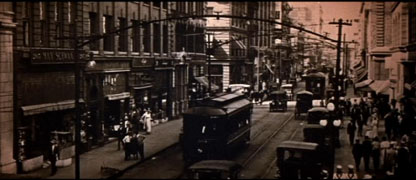 |
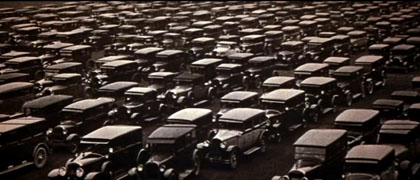 |
|
| x |
 |
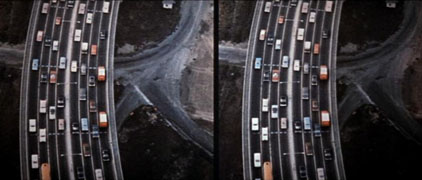 |
 |
|
| |
Christine
Leu M
The stage is set for the movie with a sequence that
highlights changes in transportation over the years. Compare this sequence
with the introduction to Just Imagine and the role of the vehicle in Things
to Come. |
|
| |
10. |
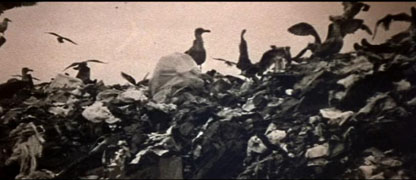 |
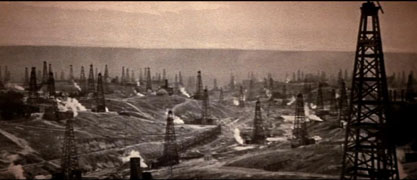 |
 |
|
| |
Jonah
Humphrey 3B
The scenario for the film relies on the development
of severe environmental degradation between 1972 and 2002. This 50 year
timeframe is identical to that proposed in Just Imagine, yet the outcomes
of the film plot are extraordinarily dissimilar. Elaborate.
Both Soylent Green and Just Imagine use a similar
technique at the opening of the respective films of successive imagery to
propel the viewer 50 years into the future. Firstly, in Just Imagine, we’re
given a brief overview of the changes that have take place between 1880
and 1930, showing as an example, the relative difficulty in crossing the
street with the invention of the automobile. Then, the viewer is propelled
another 50 years later to 1980, where the complexity of travel has attained
a new dimension, as air travel has taken over. In both instances, we see
some technical issues with technological advancements that are portrayed
as comical, if not ridiculous events. Soylent
Green too gives us a little history lesson in its still image format.
Starting with early 20th century imagery, we find see a gradual escalation
transportation issues, as with Just Imagine. The film here, delivers these
images in ever more rapid succession, with scenes of environmental wastelands,
garbage heaps and fuming factories between all of this “progress”.
This technique of speeding up the imagery alludes to the onslaught and
actual pace of development that is experienced, and what was foreseen
to happen over the next 50 years after the film was made. Most importantly
then, is the actual environmental impact that is seen as a result of the
masses of vehicular traffic, city growth, and overpopulation. The music
during this entire scene too increases its tempo, though at no point seems
that dreary or upsetting, contrasting with the imagery itself, which gives
a great feeling of unease (as felt essentially throughout the remainder
of the film).
The
comical look at what I would call technical difficulties of Just Imagine
are no doubt simply playing on the evolution of gadgetry and the rapid
development of industrialization. Contrasting this, I think then Soylent
Green’s message of our imminent destruction of the environment and
subsequent destruction of all values is a simple one to grasp, which is
constantly reinforced by either the contrasting happy (and often funky)
music, as well as the cozy (and creepily furry) surroundings the apartments
of the rich, which makes the entire experience of watching the film an
uneasy one.
|
|
| |
11. |
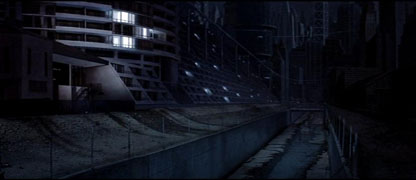 |
 |
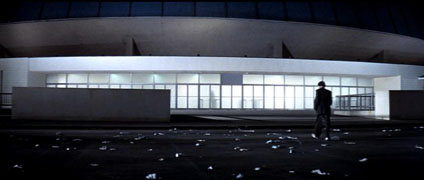 |
|
| |
Gabriel
Friedman 3B
The film proposes very distant images of a futuristic city, with more tangible
images of a dystopic setting that is not very dissimilar to the New York
City of 1972. Comment. |
|
| |
12. |
 |
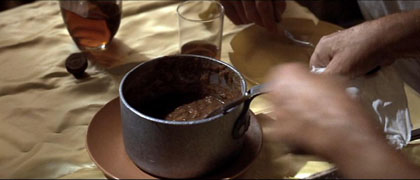 |
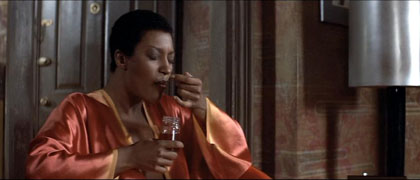 |
|
| |
Alana
Young 3B
The entire act of eating and drinking real food has been elevated to a very
high level of appreciation and enjoyment. How does this relate to a general
dulling of the senses due to a lack of differentiated sensory experience
in this film environment?
FOOD, an orgasmic experience _In
this dystopic tale of the not so distant future, characters succumb to
the smog and heat of an overworked environment. To die is to escape from
this futile existence. A severe lack of resources has detrimental affects
on every aspect of daily life, leaving 40 million New Yorkers without
work, food, or shelter.
_Commodities
once taken for granted become priceless objects of desire. While the rich
get fat off of strawberry jam and beef, the poor sleep in stairwells and
manage to sustain a pathetic form of existence through the consumption
of red, yellow and green soylent biscuits.
_The
loss of reality erases any ability to dream, imagine, experience or understand.
There is no energy left for these luxuries, life is dull, what remains
is a land of the dead and dying. Perfume is an expensive rarity, sweet
tasting foods a long forgotten memory and running water scarce.
_When
the characters are given a chance to enjoy food from the old days; it
recalls a series of long forgotten rituals. The carefully articulated
practice of eating and dining subtlety parallels a symphonic backdrop
of soothing sounds, and viewers visually experience the taste of such
a luxury. Like a deeply private moment between two lovers, the characters
first shy, and then slowly assured enjoy lettuce, apples, and beef. Suddenly
we are shook with the seriousness of the film, those things so common
to our diet could one day be gone.
_In
the scene with the furniture and the $150 jar of jam, we again experience
the extravagance of such an item. As the woman licks a spoon covered in
sweet jam, lounging in satin with the stereo blasting, our senses are
heightened to a euphoric state. Sensual and raw we are exposed to a woman’s
delight in jam and her consequential fear in being discovered.
_These
scenes serve to emphasize the underlying message of the film reminding
us that in our lack of care or concern for the environment we will soon
become the source of our own demise.
|
|
| |
13. |
 |
 |
 |
|
| |
Vincent
Plouffe M
With water for general public use rationed for essential drinking purposes,
general hygeine is now reserved for the wealthy. How does this further drive
the extreme distinction between the upper and lower classes? How is this
either consistent or inconsistent with the historic view of bathing? |
|
| |
14. |
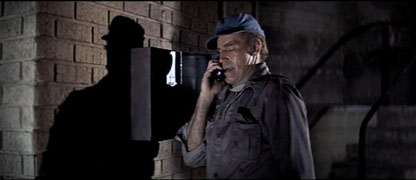 |
 |
 |
|
| |
Graham
Wolff M
Considering that the personal computer didn't appear on the scene until
after this film was produced, comment on the disparate presentation of the
role/progression/regression of technology in the New York of 2022. |
|
| |
15. |
 |
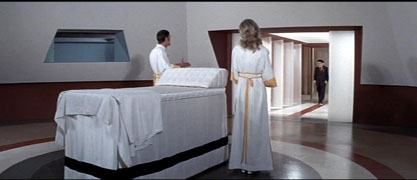 |
 |
|
| |
 |
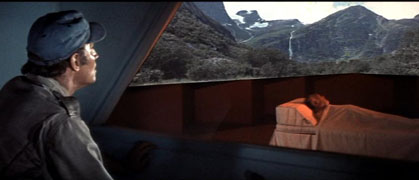 |
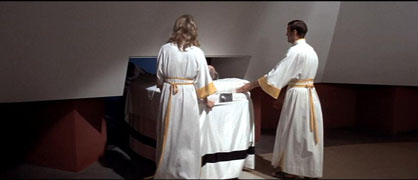 |
|
| |
Diana
Zepf 3B
Perhaps the highest level of dignity and quality of life is presented in
this sequence. Explain its significance. (If you have seen Total Recall,
you might want to make some comparisons. If not. No problem).
In a world in which the greatest human goal is to
simply stay alive, death becomes somewhat of a reprieve from struggle, an
end to suffering, and a portal to perhaps a better existence. In Soylent
Green voluntary death, euthanasia, is no longer seen as a moral fault or
a “cop out” on life, but merely another choice in life. In a
dirty overpopulated world, the process of euthanasia is the only one in
which you are treated as an important individual apart from the masses.
A customization of your own death is the only luxury that is offered to
all inhabitants (choice of their favourite colour, music, scenery, cleanliness,
etc). Does the fact that the euthanized bodies are later used to make the
rest of the world’s food supply diminish the fronted dignity given
to the “customers” at the beginning of this process? Perhaps.
Death is a choice everyone has at any given point in time, regardless of
the state of the world, environment, or politics. In Soylent Green a large
corporation under the guise of human interest offers people the choice of
death in a comfortable environment. Citizens are coerced, with “comfortable
amenities” they are not used to having, into believing that there
is no better way to continue living, and no greater richness they can attain,
than that of their own death. Yes, the corporation uses people’s dire
wants and needs for their own selfish purposes (control of the world’s
food supply), but they are also the only force that seems to recognize and
know how to address human dignity / quality of life in a world in which
the individual no longer has any meaning unto himself. |
|
| |
16. |
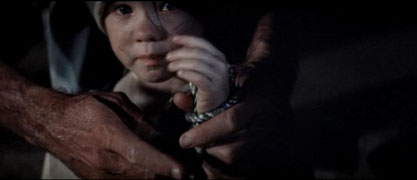 |
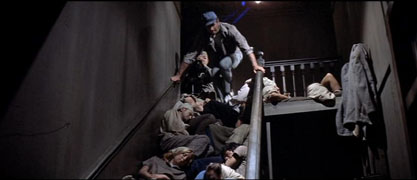 |
 |
|
| |
Diane
Skilton 3B
Curfew forbids people to be on the streets at night. Comment on how this
has changed the type/level/quality of accommodation for the "homeless"
and "unemployed" in the city.
When
looking at homeless and unemployed people today we see people sleeping on
the streets, looking through trashcans, under cardboard boxes in the rain
and snow, in bus shelters and in bank teller areas. Except for when we cross
these people in areas just mentioned we rarely have much connection and
interaction with homeless and the unemployed.
In
this film the future creates a curfew that takes all these places and
makes them not accessible. The only places that are left for homeless
and unemployed people to use are semi-public or private areas. It is very
hard to imagine this action as we often associate the homeless with people
who live out on the street. The movie is not focused upon these people,
but in Soylent Green there are powerful shots of full corridors and stairwells
with people scattered and laying everywhere. A few times the main character
actually climbs over people to his apartment. This is an image of the
future that we don’t want to even imagine.
The
portrayal and curfew of homeless people in the film Soylent Green helps
create a world that is truly “used up” and controlled. The
type of accommodation for the homeless becomes a larger demand and there
are only so many places that people can go to get away from the curfew.
The images not only show the mass of the problem, but they also show the
vulnerability of the lower class.
The
level and quality of accommodation for these people and also for the people
who live in the apartments falls dramatically. There is no room for people
to even move on the stairwells. The cleanliness and odour of these places
is only left to the imagination, but can easily be judged by the portrayal
of many people with no running water to even clean themselves.
The
overall theme of degradation, mass and control of society is easily seen
through the homeless/unemployed people. It may seem a little far fetched
for the immediate (or planned 2022) future, but the idea of so many people
and the curfew is easily believable for future societies.
|
|
| |
|
|

